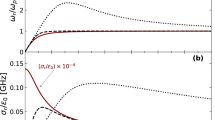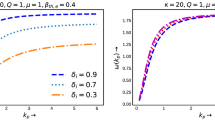Abstract
POLARISATION requirements and wave number matching dictate that a nonlinear interaction involving three electromagnetic waves that propagate in a magnetoactive plasma must necessarily be two-dimensional if one of the waves propagates parallel to the external magnetic field B0. We report here what we believe to be the first observation of a three wave interaction of this kind. Our experiment involved the production of a whistler mode wave (k3, ω3) (referred to as WMW) through the interaction of two beams of high frequency electromagnetic waves (k1, ω1) and (k2, ω2), propagating somewhat above the local plasma frequency ωp. The resonance condition for the interaction are  If ω1,2 > ωp and ω3 is sufficiently small compared with the electron gyrofrequency ωe (ωe < ωp), the high frequency beams must be directed1 almost at right angles to B0 (Fig. 1 inset). The strength of the coupling of the beams is determined by two factors: first, the magnitude of the matrix element for the interaction; and second, the time in which a stationary state is established as a result of the convection of the WMW packet across the finite interaction region of width, l. An expression2,3 for the steady-state amplitude, E3 of the electric field of the WMW, can be obtained in terms of the amplitudes E1 and E2 of the beams
If ω1,2 > ωp and ω3 is sufficiently small compared with the electron gyrofrequency ωe (ωe < ωp), the high frequency beams must be directed1 almost at right angles to B0 (Fig. 1 inset). The strength of the coupling of the beams is determined by two factors: first, the magnitude of the matrix element for the interaction; and second, the time in which a stationary state is established as a result of the convection of the WMW packet across the finite interaction region of width, l. An expression2,3 for the steady-state amplitude, E3 of the electric field of the WMW, can be obtained in terms of the amplitudes E1 and E2 of the beams  where
where  where e and m are the charge and mass of the electron, respectively, c the speed of light, μ, the refractive index for the WMW, and other symbols are as defined previously.
where e and m are the charge and mass of the electron, respectively, c the speed of light, μ, the refractive index for the WMW, and other symbols are as defined previously.
This is a preview of subscription content, access via your institution
Access options
Subscribe to this journal
Receive 51 print issues and online access
$199.00 per year
only $3.90 per issue
Buy this article
- Purchase on Springer Link
- Instant access to full article PDF
Prices may be subject to local taxes which are calculated during checkout
Similar content being viewed by others
References
Martelli, G., Giles, M., and Christiansen, P., Space Sci. Rev., 15, 891 (1974).
Giles, M., Plasma Phys. (Accel. Thermonucl. Res.), 16, 99 (1974).
Martelli, G., Giles, M., and Christiansen, P., Planet. Space Sci., 21, 2113 (1973).
Boswell, R. W., Phys. Lett., 33 A 457 (1970).
Christopoulos, C., and Christiansen, P., Plasma Phys. (Accel. Thermonucl. Res.), 16, 499 (1974).
Klozenberg, J. P., McNamara, B., and Thonemann, P. C., J. Fluid Mech., 21, 545 (1965).
Davies, B., and Christiansen, P., Plasma Phys. (Accel. Thermonucl. Res.), 11, 987 (1970).
Trivelpiece, A. W., and Gould, R. W., J. appl. Phys., 30, 1784 (1959).
Lefeuvre, F., and Bullough, K., Space Res., 13, 699 (1973).
Kaiser, T., Proc. meeting Eur. Geophys. Soc., Trieste (September 1974).
Helliwell, R. A., Space Sci. Rev., 15, 781 (1974).
Author information
Authors and Affiliations
Rights and permissions
About this article
Cite this article
CHRISTIANSEN, P., GILES, M., MARTELLI, G. et al. Observations of a nonlinear interaction involving three electromagnetic waves in a laboratory magnetoplasma. Nature 254, 683–685 (1975). https://doi.org/10.1038/254683a0
Received:
Accepted:
Issue Date:
DOI: https://doi.org/10.1038/254683a0
Comments
By submitting a comment you agree to abide by our Terms and Community Guidelines. If you find something abusive or that does not comply with our terms or guidelines please flag it as inappropriate.



